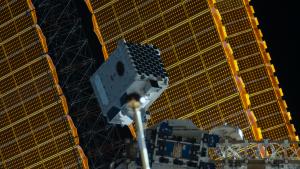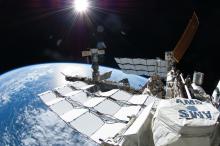NICER (Neutron Star Interior Composition Explorer), an X-ray telescope, has been operating aboard the International Space Station since 2017. Its primary targets are neutron stars, which are the ultra-dense corpses of exploded stars. NICER's observations have helped astronomers narrow the range of models of how neutron stars are structured. [NASA]
You are here
NICER Astronomy
A neutron star is among the most extreme objects in the universe. It’s so densely packed that a teaspoon of its matter would weight 10 million tons. Its gravity is so strong that an object dropped from shoulder height would smash into its surface at a few percent of the speed of light. And its magnetic field can be strong enough to rip away your wristwatch from as far away as the Moon.
But it’s also tiny — no bigger than the size of a city. And that’s a problem for the scientists who study neutron stars. They’re so small that they’re hard to measure. And without an accurate idea of a neutron star’s size, scientists can’t be sure what’s going on inside it.
One tool for finding out is NICER — the Neutron Star Interior Composition Explorer. It’s an X-ray telescope that’s been on the International Space Station since 2017.
The interior of a neutron star marks the final step before matter is basically crushed out of existence to form a black hole. So it’s unlike anything else in the universe.
It could be a big ball of neutrons. Or the neutrons could have dissolved into a “soup” of smaller particles. NICER’s observations have already helped scientists rule out some of the possibilities. But it’s looking at even more neutron stars to help scientists narrow down the options of what’s happening inside these amazing objects.
NICER technology is also helping look inside the human body; more about that tomorrow.
Script by Damond Benningfield
Get Premium Audio
Listen to today's episode of StarDate on the web the same day it airs in high-quality streaming audio without any extra ads or announcements. Choose a $8 one-month pass, or listen every day for a year for just $30.





